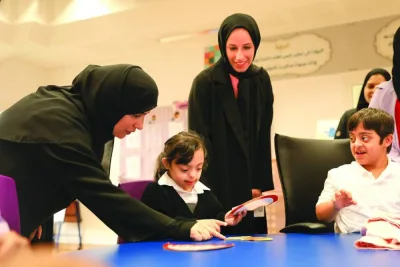Qatar Cancer Society (QCS), in collaboration with the National Center for Cancer Care and Research (NCCCR), has held an awareness activity as part of its ‘Your Skin…Your health’ campaign.
The activity was aimed at raising awareness of skin cancer and emphasising the importance of following all precautions when exposed to the sun, in addition to the importance of early detection, QCS said in a press statement.
Heba Nassar, head of the Health Education Department at QCS, said: “The activity aimed to raise awareness about skin cancer and the participants were advised to check for any mole or birthmark that is asymmetrical, one half of a mole or birthmark does not match the other, the edges are irregular, ragged, notched, or blurred, the colour is not the same all over and may include shades of brown or black, or sometimes with patches of pink, red, white or blue, the spot is larger than 6mm across, and the mole is evolving or changing in size, shape or colour.”
Nassar suggested a range of precautions to be taken while being exposed to sunlight, especially in the summer, saying: “Excessive exposure to ultraviolet radiation is the most important risk factor for any type of skin cancer. Sunlight is the main source of UV radiation so avoid direct exposure to sunlight between 10am and 4pm, and don’t forget that the sun also has a very important source for Vitamin D. There are some steps you can take to limit your exposure to UV rays - seek shade, wear protective clothing and a wide-brimmed hat.
“Also, you should use sunscreen and be sure to apply it properly, always following the label directions. Pay close attention to your face, ears, neck, arms and any other areas not covered by clothing. Put it on 20 minutes before you go outdoors, and reapply it at least every two hours to maintain protection. Ask your doctor for the suitable type for your skin in addition to wearing sunglasses, which are important for protecting the delicate skin around the eyes, as well as the eyes themselves.”
She stressed the importance of protecting children from the sun by using all types of precautions - sunscreen, sunglasses, hats and protective clothing - especially at school and during sea trips.
Early signs and symptoms include a sore that does not heal; change in sensation – itchiness, tenderness or pain; flat, firm, pale or yellow areas, similar to a scar; and small, pink or red, translucent, shiny, pearly bumps, which might have blue, brown or black areas. Also, one should look for new moles and any changes in existing moles in terms of the size, shape or colour, she added.

The awareness activity was held as part of the ‘Your Skinu2026Your health’ campaign.


